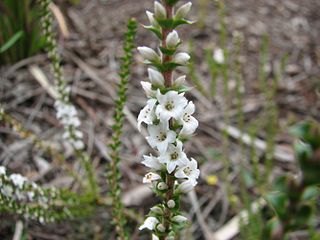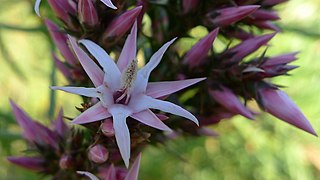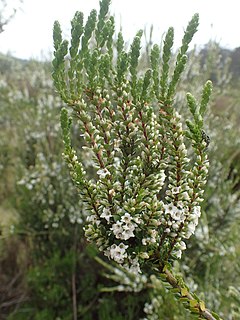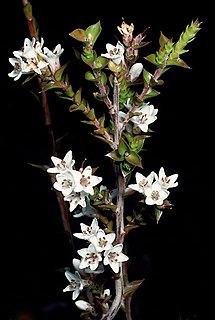
Epacris gunnii is a species of flowering plant in the family Ericaceae and is endemic to south-eastern Australia. It is an erect shrub with hairy branchlets, concave, sharply-pointed, broadly egg-shaped leaves, and tube-shaped, white flowers arranged along the stems.

Epacris microphylla , commonly known as coral heath, is a plant in the heath family Ericaceae and which is endemic to eastern Australia. It is a common, wiry shrub with tiny leaves that are often obscured by the flowers, especially near the ends of the stems. The plant sometimes grows in dense groups, giving the effect of a snowfall.

Sprengelia incarnata, commonly referred to as pink swamp-heath, is a species of flowering plant of the family Ericaceae, and is native to south-eastern Australia and New Zealand. It is an erect, glabrous shrub with sharply-pointed, stem-clasping, egg-shaped leaves, and clusters of pink, tube-shaped flowers with spreading lobes.

Epacris rhombifolia commonly known as mountain coral heath, is a plant in the heath family Ericaceae and is endemic to eastern Australia. It is an erect, multi-stemmed shrub with broad, rhombic leaves and white flowers with four petals, the flowers spreading down the branches. It only grows in wet, subalpine heath and is sometimes regarded as a variety of Epacris microphylla.

Epacris gnidioides, commonly known as Budawangs cliff-heath, is a species of flowering plant in the heath family Ericaceae and is endemic to a restricted area of New South Wales. It is a small, creeping shrub with hairy branches, sharply-pointed lance-shaped leaves, and tube-shaped, white flowers.
Epacris apsleyensis is a species of flowering plant in the heath family Ericaceae and is endemic to a small area of Tasmania. It is an erect shrub with hairy branchlets, lance-shaped to elliptic leaves and tube-shaped flowers with white petals.

Epacris cerasicollina is a species of flowering plant in the heath family Ericaceae and is endemic to Tasmania. It is a shrub with lance-shaped to egg-shaped, slightly concave leaves and tube-shaped white flowers mostly clustered in upper leaf axils.

Epacris franklinii is a species of flowering plant in the heath family, Ericaceae, and is endemic to Tasmaina. It is an erect, spreading shrub with lance-shaped or elliptic leaves and white, tube-shaped flowers.
Epacris grandis, commonly known as grand heath or tall heath, is a species of flowering plant in the heath family Ericaceae and is endemic to a small area of Tasmania. It is a robust, erect shrub with smooth stems, lance-shaped leaves and tube-shaped flowers with white petals.

Epacris graniticola, commonly known as granite heath, is a species of flowering plant in the heath family Ericaceae and is endemic to Tasmania. It is an erect shrub with egg-shaped leaves and tube-shaped white flowers mostly clustered near the ends of branches.
Epacris limbata, commonly known as bordered heath or border heath, is a species of flowering plant in the heath family Ericaceae and is endemic to a restricted area of Tasmania. It is an erect shrub with narrowly heart-shaped or broadly egg-shaped, stem-clasping, sharply-pointed leaves and tube-shaped white flowers clustered along the ends of branches.

Epacris acuminata , commonly known as claspleaf heath, is a species of flowering plant in the heath family Ericaceae and is endemic to Tasmania. It is a small, spreading shrub with egg-shaped, stem-clasping leaves and tube-shaped flowers with white petals.

Epacris mucronulata is a species of flowering plant in the heath family Ericaceae and is endemic to Tasmania. It is an erect shrub with softly-hairy young branches, lance-shaped leaves, and cylindrical white flowers in small groups at the ends of the branches.
Sprengelia distichophylla is a species of flowering plant in the heath family Ericaceae and is endemic to Tasmania. It is a tufted shrub that typically grows to a height of 51–76 mm (2.0–3.0 in) with leaves about 2 mm (0.079 in) long, arranged in two closely overlapping rows, with the bases sheathing the stem. The flowers are arranged singly in leaf axils and are white, about 5 mm (0.20 in) long and bell-shaped. Flowering occurs in summer.
Epacris navicularis is a species of flowering plant in the heath family Ericaceae and is endemic to south-western Tasmania. It is a shrub with crowded, overlapping egg-shaped leaves arranged in five rows, and bell-shaped white flowers crowded in upper leaf axils.
Epacris pilosa is a species of flowering plant in the heath family Ericaceae and is endemic to eastern New South Wales. It is low-lying shrub with weeping, shaggy-hairy branchlets, elliptic to more or less egg-shaped leaves and white or cream-coloured tube-shaped flowers.
Sprengelia montana is a species of flowering plant of the family Ericaceae, and is endemic to Tasmania. It is a small, erect shrub with overlapping, stem-clasping, egg-shaped leaves, and pink flowers, sometimes in groups of up to 10 on the ends of branches.

Sprengelia propinqua is a species of flowering plant of the family Ericaceae, and is endemic to Tasmania. It is an erect, robust shrub with overlapping, stem-clasping, egg-shaped leaves, and white flowers crowded in upper leaf axils.

Sprengelia sprengelioides is a species of flowering plant of the family Ericaceae, and is endemic to near-coastal areas of eastern Australia. It is an erect shrub with egg-shaped leaves, and white flowers arranged singly in leaf axils.

Epacris tasmanica is a species of flowering plant in the heath family Ericaceae and is endemic to Tasmania. It is an erect shrub with lance-shaped leaves and tube-shaped white flowers crowded in upper leaf axils.












